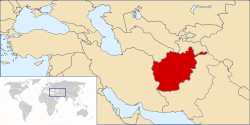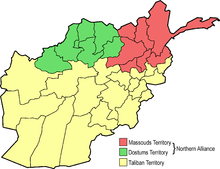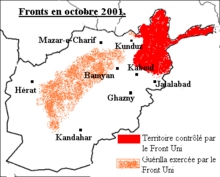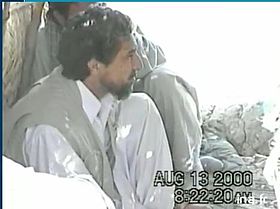- Northern Alliance
-
For other uses, see Northern Alliance (disambiguation).
United Islamic Front Participant in War in Afghanistan (1996-2001), War in Afghanistan (2001–present) 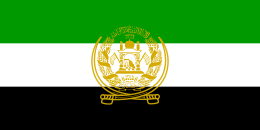
Flag flown by the United Islamic FrontActive September 1996–October 2001 Ideology Islamic democracy
Moderate IslamLeaders Ahmad Shah Massoud
Haji Abdul Qadir
Hussain Anwari
Rashid Dostum (until 1998)Area of
operationsAfghanistan Allies from September 2001: ISAF Opponents Taliban & Pakistan Army
Al-QaedaIslamic State of Afghanistan
دولت اسلامی افغانستان← 
1992–2001
 →
→
 →
→

Flag Coat of arms Capital Kabul de facto from 1992 to 1996 then Northern Afghanistan till 2001 Language(s) Persian, Pashto Government Islamic republic President - 1992–2001 Burhanuddin Rabbani History - Established 1992 - Disestablished 2001 The United Islamic Front (United Islamic Front for the Salvation of Afghanistan, UIF, Jabha-yi Muttahid-i Islami-yi Milli bara-yi Nijat-i Afghanistan), known in the West and Pakistan as the Northern Alliance, was a military-political umbrella organization created by the Islamic State of Afghanistan in 1996 under the leadership of Defense Minister Ahmad Shah Massoud. The organization united all ethnic groups of Afghanistan fighting against the Afghan Taliban who were supported by neighboring Pakistan and Bin Laden's Al Qaeda. The United Front included Tajiks, Pashtuns, Hazaras, Uzbeks, Turkmen and others.
In late 2001, after the September 11 terrorist attacks on U.S. soil that killed 3,000 people, the United Front succeeded in retaking most of Afghanistan from the Taliban with assistance from the United States armed forces, U.S. special forces, British armed forces and British Special forces. Despite fears of a return to the chaos similar to that of the 1992–1996 civil war, all the different UIF factions accepted the new interim Karzai administration led by Afghan President Hamid Karzai.
Contents
Commanders and factions
Beside Ahmad Shah Massoud the best-known commanders of the United Front were:
- (from the north) Bismillah Khan Mohammadi, Atta Mohammad Noor, Mohammad Daoud Daoud, Qasim Fahim, Gul Haider, Haji Mohammad Mohaqeq, Rashid Dostum, Qazi Kabir Marzban;
- (from the east) Haji Abdul Qadir, Hazrat Ali, Jaan Daad Khan and Abdullah Wahedi, Qatrah and Najmuddin;
- (from the south) Qari Baba, Noorzai and Hotak;
- (from the west and southwest) Ismail Khan, Doctor Ibrahim, and Fazlkarim Aimaq;
- (from central Afghanistan) Hussain Anwari, Said Hussein Aalemi Balkhi, Said Mustafa Kazemi, Akbari, Mohammad Ali Jawed, Karim Khaili and Sher Alam.
The political parties (factions) in contrast to the commanders played only a minor role in the war against the Taliban:
- Islamic Party of Afghanistan - Jamiat-i Islami - Made up of mainly Persian-speaking Sunni Tajiks officially led by Burhanuddin Rabbani.
- Islamic Movement of Afghanistan - Harakat-i Islami - Shia Tajiks and Hazaras led by Ayatollah Muhammad Asif Muhsini.
- Islamic Unity Party of Afghanistan - Hezb-i Wahdat - Made up of Shia Hazaras and supported by Iran, led by Mohammed Mohaqiq and Karim Khalili.
- National Islamic Movement of Afghanistan - Junbish-i Milli - Made up of Uzbeks and former communists, led by Abdul Rashid Dostum.
- Islamic Union for the Liberation of Afghanistan - Ittihad-i Islami - Sunni Pashtuns, led by Abdul Rasul Sayyaf.
- Eastern Shura - Sunni Pashtuns led by Abdul Qadir
The two main political candidates in the Afghan Presidential Elections of 2009 both worked for the United Front:- Abdullah Abdullah (was a close friend of Ahmad Shah Massoud and the foreign minister of the alliance)
- Hamid Karzai (his father was killed by the Taliban, he subsequently went on a diplomatic mission to gather support for Massoud in Europe and the U.S. in 2000/2001)
History
Background
After the fall of the communist Najibullah-regime in 1992, the Afghan political parties agreed on a peace and power-sharing agreement (the Peshawar Accords).[1] The Peshawar Accords created the Islamic State of Afghanistan.[1] From the first day of its founding until late 1994, the newly-created Islamic State of Afghanistan (ISA) came under attack by Gulbuddin Hekmatyar's Hezb-i Islami militia armed, financed and instructed by neighboring Pakistan.[2] Afghanistan expert Amin Saikal concludes in Modern Afghanistan: A History of Struggle and Survival:
Pakistan was keen to gear up for a breakthrough in Central Asia. [...] Islamabad could not possibly expect the new Islamic government leaders [...] to subordinate their own nationalist objectives in order to help Pakistan realize its regional ambitions. [...] Had it not been for the ISI's logistic support and supply of a large number of rockets, Hekmatyar's forces would not have been able to target and destroy half of Kabul.[3]Abdul Rashid Dostum and his Junbish-i Milli militia joined an alliance with Hekmatyar in early 1994. In addition, Saudi Arabia and Iran - as competitors for regional hegemony - supported Afghan militias hostile towards each other.[3] According to Human Rights Watch, Iran was assisting the Shia Hazara Hezb-i Wahdat forces of Abdul Ali Mazari, as Iran was attempting to maximize Wahdat's military power and influence.[1][3][4] Saudi Arabia supported the Wahhabite Abdul Rasul Sayyaf and his Ittihad-i Islami faction.[1][3] Conflict between the two militias soon escalated into a full-scale war. The capital city Kabul saw extremely violent fighting during that period.[2] Power was highly decentralized.
Meanwhile, southern Afghanistan was neither under the control of foreign-backed militias nor the government in Kabul, but was ruled by local leaders such as Gul Agha Sherzai and their militias. In 1994, the Taliban (a movement originating from Jamiat Ulema-e-Islam-run religious schools for Afghan refugees in Pakistan) also developed in Afghanistan as a politico-religious force, reportedly in opposition to the tyranny of the local governor in Kandahar.[5] In 1994, the Taliban took power in several provinces in southern and central Afghanistan.
In late 1994, most of the militia factions (Hezb-i Islami, Junbish-i Milli and Hezb-i Wahdat) which had been fighting in the battle for control of Kabul were defeated militarily in Kabul by forces of the Islamic State's Secretary of Defense Ahmad Shah Massoud. Bombardment of the capital came to a halt.[6][7] Massoud tried to initiate a nationwide political process with the goal of national consolidation and democratic elections, also inviting the Taliban to join the process.[8] The Taliban declined.[8] They started shelling Kabul in early 1995 but were defeated by forces of the Islamic State government under Secretary of Defense Ahmad Shah Massoud.[6] On September 26, 1996, as the Taliban with military support by Pakistan and financial support by Saudi Arabia prepared for another major offensive, Massoud ordered a full retreat from Kabul.[9] The Taliban seized Kabul on September 27, 1996, and established the Islamic Emirate of Afghanistan. The Islamic State government remained the internationally recognized government of Afghanistan. The Taliban's Islamic Emirate received recognition only from Saudi Arabia, Pakistan and the United Arab Emirates. The Taliban imposed on the parts of Afghanistan under their control their political and judicial interpretation of Islam issuing edicts forbidding women to work outside the home, attend school, or to leave their homes unless accompanied by a male relative.[10]
Creation of the United Front
Ahmad Shah Massoud and Abdul Rashid Dostum, two former archnemesis, created the United Front (Northern Alliance) against the Taliban that were preparing offensives against the remaining areas under the control of Massoud and those under the control of Dostum. see video The United Front included beside the dominantly Tajik forces of Massoud and the Uzbek forces of Dostum, Hazara factions and Pashtun forces under the leadership of commanders such as Abdul Haq, Haji Abdul Qadir, Qari Baba or diplomat Abdul Rahim Ghafoorzai. From the Taliban conquest in 1996 until November 2001 the United Front controlled roughly 30% of Afghanistan's population in provinces such as Badakhshan, Kapisa, Takhar and parts of Parwan, Kunar, Nuristan, Laghman, Samangan, Kunduz, Ghōr and Bamyan.
The Taliban defeated Dostum's Junbish forces militarily by seizing Mazar-i-Sharif in 1998. Dostum subsequently went into exile.
Pakistani military interference
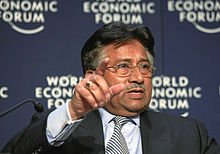 Former Pakistani President Pervez Musharraf sent tens of thousands of Pakistani nationals to fight alongside the Taliban.
Former Pakistani President Pervez Musharraf sent tens of thousands of Pakistani nationals to fight alongside the Taliban.
Pakistani President Pervez Musharraf - then as Chief of Army Staff and Chairman of Joint Chiefs of Staff Committee - was responsible for sending thousands of Pakistanis to fight alongside the Taliban and Bin Laden against the forces of Massoud.[8][11][12][13] In total there were believed to be 28,000 Pakistani nationals, under the command of General Naseem Rana, fighting inside Afghanistan against the forces of Massoud.[8] 20,000 were regular Pakistani soldiers either from the Frontier Corps or Army and an estimated 8,000 were militants recruited in madrassas filling regular Taliban ranks under the command of principle military leader of Pakistan combatant forces General Naseem Rana.[14] The estimated 25,000 Taliban regular force thus comprised more than 8,000 Pakistani nationals.[14] A 1998 document by the U.S. State Department confirms that "20-40 percent of [regular] Taliban soldiers are Pakistani."[11] The document further states that the parents of those Pakistani nationals "know nothing regarding their child's military involvement with the Taliban until their bodies are brought back to Pakistan."[11] A further 3,000 fighter of the regular Taliban army were Arab and Central Asian militants.[14] From 1996 to 2001 the Al Qaeda of Osama Bin Laden and Ayman al-Zawahiri became a state within the Taliban state.[15] Bin Laden sent Arab recruits to join the fight against the United Front.[15][16] Of roughly 45,000 Pakistani, Taliban and Al Qaeda soldiers fighting against the forces of Massoud only 14,000 were Afghan.[14][8]
Taliban massacres
According to a 55-page report by the United Nations, the Taliban, while trying to consolidate control over northern and western Afghanistan, committed systematic massacres against civilians.[17][18] UN officials stated that there had been "15 massacres" between 1996 and 2001.[17][18] They also said, that "[t]hese have been highly systematic and they all lead back to the [Taliban] Ministry of Defense or to Mullah Omar himself."[17][18] Al Qaeda's so-called 055 Brigade was also responsible for mass-killings of Afghan civilians.[14] The report by the United Nations quotes eyewitnesses in many villages describing Arab fighters carrying long knives used for slitting throats and skinning people.[17][18]
Ahmad Shah Massoud
“ The only thing standing in the way of future Taliban massacres is Ahmad Shah Massoud.[19] ” Ahmad Shah Massoud remained the only leader of the United Front in Afghanistan. The Taliban repeatedly offered Massoud a position of power to make him stop his resistance. Massoud declined. He explained in one interview:
- "The Taliban say: “Come and accept the post of prime minister and be with us”, and they would keep the highest office in the country, the presidentship. But for what price?! The difference between us concerns mainly our way of thinking about the very principles of the society and the state. We can not accept their conditions of compromise, or else we would have to give up the principles of modern democracy. We are fundamentally against the system called “the Emirate of Afghanistan”."[20]
- "There should be an Afghanistan where every Afghan finds himself or herself happy. And I think that can only be assured by democracy based on consensus."[21]
Massoud wanted to convince the Taliban to join a political process leading towards democratic elections in a foreseeable future.[20][22] He also stated:
- "The Taliban are not a force to be considered invincible. They are distanced from the people now. They are weaker than in the past. There is only the assistance given by Pakistan, Osama bin Laden and other extremist groups that keep the Taliban on their feet. With a halt to that assistance, it is extremely difficult to survive."[21]
In early 2001 the United Front employed a new strategy of local military pressure and global political appeals.[23] Resentment was increasingly gathering against Taliban rule from the bottom of Afghan society including the Pashtun areas.[23] In total, estimates range up to one million people fleeing the Taliban.[24] Many civilians fled to the area of Ahmad Shah Massoud.[12][25] National Geographic concluded in its documentary "Inside the Taliban": "The only thing standing in the way of future Taliban massacres is Ahmad Shah Massoud."[12] In the areas under his control Massoud set up democratic institutions and signed the Women's Rights Declaration.[8] At the same time he was very wary not to revive the failed Kabul government of the early 1990s.[23] Already in 1999 the United Front leadership ordered the training of police forces specifically to keep order and protect the civilian population in case the United Front would be successful.[8] In early 2001 Ahmad Shah Massoud addressed the European Parliament in Brussels asking the international community to provide humanitarian help to the people of Afghanistan.(see video)[24] He stated that the Taliban and Al Qaeda had introduced "a very wrong perception of Islam" and that without the support of Pakistan and Bin Laden the Taliban would not be able to sustain their military campaign for up to a year.[24] On this visit to Europe he also warned that his intelligence had gathered information about a large-scale attack on U.S. soil being imminent.[26]
On September 9, 2001, two Arab suicide attackers, allegedly belonging to Al Qaeda, posing as journalists, detonated a bomb hidden in a video camera while interviewing Ahmed Shah Massoud in the Takhar province of Afghanistan. Commander Massoud died in a helicopter that was taking him to a hospital. He was buried in his home village of Bazarak in the Panjshir Valley.[27] The funeral, although taking place in a rather rural area, was attended by hundreds of thousands of mourning people. Sad day (video clip).
The assassination of Massoud is considered to have a strong connection to the September 11, 2001 attacks on U.S. soil which killed nearly 3000 people and which appeared to be the terrorist attack that Massoud had warned against in his speech to the European Parliament several months earlier. John P. O'Neill was a counter-terrorism expert and the Assistant Director of the FBI until late 2001. He retired from the FBI and was offered the position of director of security at the World Trade Center (WTC). He took the job at the WTC two weeks before 9/11. On September 10, 2001, John O’Neill told two of his friends,
- "We're due. And we're due for something big. ... Some things have happened in Afghanistan [referring to the assassination of Massoud]. I don’t like the way things are lining up in Afghanistan. ... I sense a shift, and I think things are going to happen. ... soon."[28]
John O'Neill died on September 11, 2001, when the south tower collapsed.[28]
After the terrorist attacks of September 11, 2001, United Front troops ousted the Taliban from power in Kabul with American air support in Operation Enduring Freedom, using intelligence reports offered by Iran during the Six plus Two Group meetings at the United Nations Headquarters. In November and December 2001 the United Front gained control of much of the country and played a crucial role in establishing the post-Taliban interim government of Hamid Karzai in late 2001.
Human rights (1997–2001)
The human rights situation during combat was heavily dependent on the specific commander and his troops. The situation for different leaders and their troops of the United Front thus shows sharp contrasts. Also, the quality of life of the Afghan population was heavily dependent on the specific leader that was directly controlling the area in which they lived. Sharp contrasts could also be witnessed regarding life and structures in those areas.
Area of Massoud
Massoud directly controlled the Panjshir, some other parts of Parwan and Thakar province. Some parts of Badakshan were under his influence while others were controlled by Burhanuddin Rabbani with whom Massoud had some non-violent disputes. (Badakshan is the home region of Rabbani.)
Human Rights Watch cites no human rights crimes or abuses for Massoud's troops in the period from October 1996 until the assassination of Massoud in September 2001. Massoud created democratic institutions which were structured into several committees: political, health, education and economic.[8] In the area of Massoud women and girls did not have to wear the Afghan burqa.[8] They were allowed to work and to go to school.[8] In at least two known instances Massoud personally intervened against cases of forced marriage.[8] While it was Massoud's stated conviction that men and women are equal and should enjoy the same rights, he also had to deal with Afghan traditions which he said would need a generation or more to overcome. In his opinion that could only be achieved through education.[8]
Hundreds of thousands of refugees fled the Taliban to the areas of Massoud.[29] There was a huge humanitarian problem because there was not enough to eat for both the existing population and the refugees. In 2001 Massoud and a French journalist described the bitter situation of the refugees and asked for humanitarian help.[29] see video
Area of Dostum
Until the defeat of Dostum by the Taliban in 1998 he controlled the following provinces: Samangan, Balkh, Jowzjan, Faryab, and Baghlan provinces. According to Human Rights Watch many of the violations of international humanitarian law committed by the United Front forces date from 1996-1998[30] when Dostum controlled most of the north.
According to Human Rights Watch in 1997 some 3,000 captured Taliban soldiers were summarily executed in and around Mazar-i Sharif by Dostum's Junbish forces under the command of Gen. Abdul Malik Pahlawan. The killings followed Malik's withdrawal from a brief alliance with the Taliban and the capture of the Taliban forces who were trapped in the city.[30] With the U.S. War on Terror, troops loyal to Dostum also returned to combat. In December 2001 during the U.S. invasion of Afghanistan between 250 and 3,000 (depending on sources) Taliban prisoners were shot and/or suffocated to death in metal truck containers, while being transferred by U.S. and United Front (troops loyal to Dostum) soldiers from Kunduz to Sheberghan prison through the Dasht-i-Leili desert in Afghanistan. This became known as the so-called Dasht-i-Leili massacre[31] In 2009 Dostum denied the accusations.[32][33][34]
Dostum belonged to those commanders making their own, often draconian, laws. Human Rights Watch has released documents alleging widespread crimes targeted against the civilian population.[30] Human Rights Watch asked to actively discourage and refuse support in any way to any group or coalition that includes commanders with a record of serious violations of international humanitarian law standards, specifically naming Abdul Rashid Dostum; Haji Muhammad Muhaqqiq, a senior commander of the Hezb-i Wahdat; Abdul Rasul Sayyaf, leader of the erstwhile Ittihad-i Islami; and Abdul Malik Pahlawan, a former senior Junbish commander.[30]
Legacy
 United Front troops lined up next to the runway at Bagram Air Base in Afghanistan, December 16, 2001.
United Front troops lined up next to the runway at Bagram Air Base in Afghanistan, December 16, 2001.
The United Front, from 1996 to 2001, blocked the Taliban, Pakistan and Al Qaeda from gaining total control over all of Afghanistan. Many refugees found shelter in areas controlled by Ahmad Shah Massoud.
After the attacks of September 11, 2001, on U.S. soil (which killed 3000 people) ground troops of the United Front ousted the Taliban from power in Kabul. In November and December 2001 the United Front gained control of much of the country. This was facilitated by extensive bombing of Taliban forces and military infrastructure by the United States during the U.S.-led attack on Afghanistan. Had it not been for the United Front the U.S. would have needed to deploy hundreds of thousands of ground troops to Afghanistan already in October 2001.
The United Front was extremely influential in the transitional Afghan Government of Hamid Karzai from 2001 until 2004. Notably, Mohammed Qasim Fahim became the Vice President and Minister of Defense, Yunus Qanuni became the Minister of Education and Security Advisor and Dr. Abdullah Abdullah became the Foreign Minister. Most foreign observers expected this dominance to continue and for Fahim or Qanuni to be selected as Karzai's Vice President in the 2004 elections. However, Karzai instead selected Ahmad Zia Massoud, younger brother of the former United Front leader Ahmad Shah Massoud. Karzai easily won the 2004 Presidential election with 55.4% of the vote, followed by three former leaders of the UIF, Quanuni (16.3%), Mohaqiq (11.7%) and Dostum (10%).
Some of the military strength of the UIF has now been absorbed into the Military of Afghanistan, while many of the remaining soldiers were disarmed through a nationwide disarmament program. The existence and strength of the Afghan National Army has significantly reduced the threat of the former UIF elements attempting to use military action against the new NATO-backed government. Most of the country's senior military personnel are former members of the UIF, including Defense Minister Abdul Rahim Wardak and General Bismillah Khan.
Some members of the alliance are now part of the United National Front (Afghanistan) which is led by Rabbani and includes some former leaders of the UIF such as Parliamentary Speaker Yunus Qanuni, Mohammed Fahim, and Abdul Rashid Dostum. The United National Front has positioned itself as a "loyal" opposition to Karzai. Others like Abdul Sayyaf claim to be loyal to Hamid Karzai while, however, following their own agenda. Sayyaf has strong ties to the Saudi establishment and wants to create a strong Wahhabi influence on Afghanistan.
Dr. Abdullah Abdullah, a doctor of medicine and one of Ahmad Shah Massoud's closest friends (who is said to have been close to him politically also), ran as an independent candidate in the 2009 Afghan presidential election and came in second place. On November 1, 2009, Abdullah, however, quit the runoff election because of widespread allegations of election fraud against Hamid Karzai.[35] His followers wanted to take to the streets but Abdullah held them back in order not to endanger the fragile stability of the government. Massoud Khalili, another of Ahmad Shah Massoud's close friends, became ambassador to India and subsequently to Turkey, while the younger brother of Massoud, Ahmad Wali Massoud, serves as ambassador to the United Kingdom. Massoud's ex-commander Bismillah Khan was army chief of staff for a long time rebuilding the Afghan armed forces until he was shifted to the position of interior minister in 2010 by Karzai. One of Massoud's close intelligence agents, Amrullah Saleh, became director of the Afghan National Directorate of Security in 2004 but had to resign in 2010 because of disagreements with Hamid Karzai over how to proceed against the Taliban and Pakistani support to the Taliban.
See also
- Ahmad Shah Massoud
- War in Afghanistan (1996-2001)
- War in Afghanistan (2001–present)
- Amrullah Saleh
- Abdullah Abdullah
- Haron Amin
References
- ^ a b c d "Blood-Stained Hands, Past Atrocities in Kabul and Afghanistan's Legacy of Impunity". Human Rights Watch. http://www.hrw.org/en/reports/2005/07/06/blood-stained-hands.
- ^ a b Neamatollah Nojumi. The Rise of the Taliban in Afghanistan: Mass Mobilization, Civil War, and the Future of the Region (2002 1st ed.). Palgrave, New York.
- ^ a b c d Amin Saikal. Modern Afghanistan: A History of Struggle and Survival (2006 1st ed.). I.B. Tauris & Co Ltd., London New York. p. 352. ISBN 1-85043-437-9.
- ^ GUTMAN, Roy (2008): How We Missed the Story: Osama Bin Laden, the Taliban and the Hijacking of Afghanistan, Endowment of the United States Institute of Peace, 1st ed., Washington D.C.
- ^ Matinuddin, Kamal, The Taliban Phenomenon, Afghanistan 1994–1997, Oxford University Press, (1999), pp.25–6
- ^ a b Amnesty International. "DOCUMENT - AFGHANISTAN: FURTHER INFORMATION ON FEAR FOR SAFETY AND NEW CONCERN: DELIBERATE AND ARBITRARY KILLINGS: CIVILIANS IN KABUL." 16 November 1995 Accessed at: http://www.amnesty.org/en/library/asset/ASA11/015/1995/en/6d874caa-eb2a-11dd-92ac-295bdf97101f/asa110151995en.html
- ^ "Afghanistan: escalation of indiscriminate shelling in Kabul". International Committee of the Red Cross. 1995. http://www.icrc.org/eng/resources/documents/misc/57jly2.htm.
- ^ a b c d e f g h i j k l Marcela Grad. Massoud: An Intimate Portrait of the Legendary Afghan Leader (March 1, 2009 ed.). Webster University Press. pp. 310.
- ^ Coll, Ghost Wars (New York: Penguin, 2005), 14.
- ^ "The Taliban's War on Women. A Health and Human Rights Crisis in Afghanistan". Physicians for Human Rights. 1998. http://physiciansforhumanrights.org/library/documents/reports/talibans-war-on-women.pdf.
- ^ a b c "Documents Detail Years of Pakistani Support for Taliban, Extremists". George Washington University. 2007. http://www.gwu.edu/~nsarchiv/NSAEBB/NSAEBB227/index.htm#17.
- ^ a b c "Inside the Taliban". National Geographic. 2007. http://www.youtube.com/watch?v=xpQI6HKV-ZY&feature=related.
- ^ "History Commons". History Commons. 2010. http://www.historycommons.org/entity.jsp?entity=ahmed_shah_massoud.
- ^ a b c d e "Afghanistan resistance leader feared dead in blast". Ahmed Rashid in the Telegraph. 2001. http://www.telegraph.co.uk/news/worldnews/asia/afghanistan/1340244/Afghanistan-resistance-leader-feared-dead-in-blast.html.
- ^ a b "BOOK REVIEW: The inside track on Afghan wars by Khaled Ahmed". Daily Times. 2008. http://www.dailytimes.com.pk/default.asp?page=2008\08\31\story_31-8-2008_pg3_4.
- ^ "Brigade 055". CNN. unknown. http://www.youtube.com/watch?v=Grugy2txSvc&feature=search.
- ^ a b c d Newsday (October 2001). "Taliban massacres outlined for UN". Chicago Tribune. http://articles.chicagotribune.com/2001-10-12/news/0110120312_1_taliban-fighters-massacres-in-recent-years-mullah-mohammed-omar.
- ^ a b c d Newsday (2001). "Confidential UN report details mass killings of civilian villagers". newsday.org. http://www.papillonsartpalace.com/massacre.htm. Retrieved October 12, 2001.
- ^ Inside the Taliban National Geographic
- ^ a b "The Last Interview with Ahmad Shah Massoud". Piotr Balcerowicz. 2001. http://www.orient.uw.edu.pl/balcerowicz/texts/Ahmad_Shah_Masood_en.htm.
- ^ a b "The man who would have led Afghanistan". St. Petersburg Times. 2002. http://www.sptimes.com/2002/09/09/911/The_man_who_would_hav.shtml.
- ^ "Proposal for Peace, promoted by Commander Massoud". peace-initiatives.com. 1998. http://www.peace-initiatives.com/frame.htm.
- ^ a b c Steve Coll. Ghost Wars: The Secret History of the CIA, Afghanistan, and Bin Laden, from the Soviet Invasion to September 10, 2001 (February 23, 2004 ed.). Penguin Press HC. p. 720.
- ^ a b c "Massoud in the European Parliament 2001". EU media. 2001. http://www.youtube.com/watch?v=t78N6Q5VD60.
- ^ "Inside the Taliban". National Geographic. 2007. http://channel.nationalgeographic.com/episode/inside-the-taliban-3274/Overview.
- ^ Defense Intelligence Agency (2001) report http://www.gwu.edu/~nsarchiv/NSAEBB/NSAEBB97/tal31.pdf
- ^ "Rebel Chief Who Fought The Taliban Is Buried"
- ^ a b "The Man Who Knew". PBS. 2002. http://www.pbs.org/wgbh/pages/frontline/shows/knew/etc/script.html.
- ^ a b "Massoud in the European Parliament 2001". EU media. 2001. http://www.youtube.com/watch?v=e1iCsEnXdIw.
- ^ a b c d "Human Rights Watch Backgrounder, October 2001". Human Rights Watch. 2001. http://www.hrw.org/backgrounder/asia/afghan-bck1005.htm#uf.
- ^ "Starved, hurt and buried alive in Afghanistan". Independent Online. 2002-05-02. Archived from the original on 2009-08-07. http://www.webcitation.org/query?url=http%3A%2F%2Fwww.iol.co.za%2Findex.php%3Fset_id%3D1%26click_id%3D3%26art_id%3Dqw1020329461747B212&date=2009-08-07. Retrieved 2009-08-07.
- ^ "'It Is Impossible Prisoners Were Abused' "
- ^ Afghan Warlord Denies Links to ’01 Killings "
- ^ "A Response To General Dostum"
- ^ Afghan's Karzai effectively handed 2nd term
External links
- Starving to Death Afghanistan (documentary report March 1995) by Journeyman Pictures/ABC Australia
- Massoud's Last Stand - Afghanistan (documentary report 1997) by Journeyman Pictures/ABC Australia
- Inside the Taliban (documentary film 2007) by the National Geographic
- Other
- The Last Interview with Ahmad Shah Massoud Piotr Balcerowicz, early August 2001]
- Proposal for Peace, promoted by Commander Massoud, in English in Dari (Persian)
- Northern Alliance at FAS
- Who are the Northern Alliance?, BBC, 13 November, 2001
- Afghanistan's Northern Alliance, BBC, 19 September, 2001
- Human Rights Watch on the UIF
Categories:- Former countries in South Asia
- States and territories established in 1992
- States and territories disestablished in 2001
- Afghan Civil War
- Defunct Islamic organizations
- Military history of Afghanistan
- Military units and formations established in 1996
- Organizations disestablished in 2002
- War in Afghanistan (2001–present)
- Islamic State of Afghanistan
Wikimedia Foundation. 2010.

